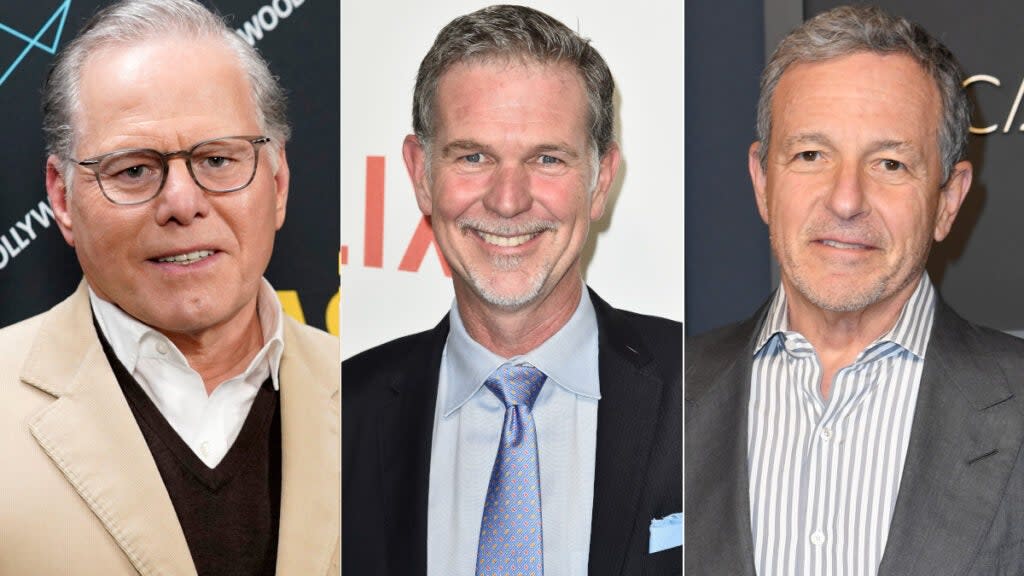Sky-High Hollywood Exec Pay Is Target in WGA Strike: ‘Workers Who Write Their Shows Can’t Afford Rent’

- Oops!Something went wrong.Please try again later.
Hollywood executives’ pay has become a significant topic of conversation in the wake of the writer’s strike, after the WGA was unable to reach a deal in contract negotiations with the Alliance of Motion Picture and Television Producers.
The guild has shared an infographic that outlines the $773 million in combined salary that eight major Hollywood studio CEOs made in 2021. They include Endeavor CEO Ari Emanuel ($308.2 million), Warner Bros. Discovery CEO David Zaslav ($246.6 million), Disney’s former chief executive officer Bob Chapek ($32.5 million) and then-executive chairman Bob Iger ($45.9 million), Fox Corporation executive chairman Rupert Murdoch ($31.1 million), Netflix former co-CEO and current executive chairman Reed Hastings ($40.8 million) and co-CEO Ted Sarandos ($38.2 million) and Comcast CEO Brian Roberts ($30 million).
“Meanwhile, many of the workers who write their shows can’t afford rent,” the infographic adds. “That’s why the WGA is ready to strike.”
All of us at @sagaftra stand with @WGAWest and @WGAEast. Because this is fucking ridiculous. pic.twitter.com/lE8sYvdQ8N
— Bradley Whitford (@BradleyWhitford) May 2, 2023
“All of us at @sagaftra stand with WGAWest and @WGAEast,” actor Bradley Whitford tweeted along with the infographic. “Because this is f–ing ridiculous.”
Also Read:
Hollywood Writers Go on Strike as WGA, Studios Fail to Reach Deal
In its statement announcing that a deal had not been reached, the WGA said that “mandatory staffing,” and “duration of employment” were the “primary sticking points” when it came to the failed negotiations. In a side-by-side chart released by the WGA to its members in the email announcing the start of the strike, more information was given on what the two sides were proposing in talks.
For its mandatory staffing proposals, the WGA’s proposal called for at least six writers for “mini-rooms,” which are writers rooms created before a project is even greenlit to generate more scripts for studio consideration. Of those minimum six writers, at least four must have writer-producer status, ensuring higher minimum rates.
After a show is greenlit, the WGA proposal would also ensure that every writers room employs between six-12 writers depending on the number of episodes ordered. The WGA also proposed a guaranteed minimum of 10 weeks of work for mini-rooms and requirements that at least half of the minimum number of writers on greenlit productions remain employed during the entirety of production among other rules regarding proposed minimum employment times.
The WGA said in interviews and membership memos prior to the start of talks that such proposals were necessary to reverse the downward trend of real wages for writers, as streaming has led to shorter episode orders and mini-rooms where writers work at minimum rates.
But on both of these issues, the AMPTP rejected the WGA proposals without a counter-offer. Studio insiders told TheWrap that requirements on how many writers are employed and how long would be non-starters for the studios, as they see control over employment as their prerogative.
The WGA and AMPTP had come to an agreement on some issues, including increasing the earnings cap on span protections and exclusivity to allow for higher wages for writer-producers and showrunners. Span protections would also be extended to writers on limited series, ensuring greater pay for shows like “The White Lotus” beyond minimum rates.
But the AMPTP’s proposed increases on minimum rates only reached 2-4% depending on the position, while WGA was looking for 5-6% increases. WGA also sought a 25% premium increase on weekly pay for all mini-rooms, while AMPTP countered with just a 5% increase that would apply “only when 3 or more writers (including teams) are hired for 10 or fewer weeks before a season 1 of a series.
Picket lines will begin in front of all the major studios and production offices in Los Angeles and New York starting at 1 p.m. local time on Tuesday. The strike is likely to last at least through late June as the AMPTP pivots to negotiations with the Directors Guild of America and SAG-AFTRA.
Jeremy Fuster contributed to this report
Also Read:
The Sticking Points: Writers Guild Breaks Down Why It Couldn’t Reach a Deal With Studios

